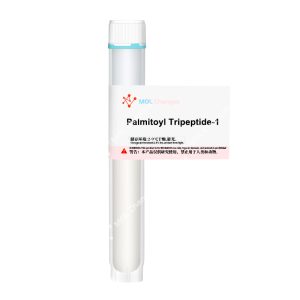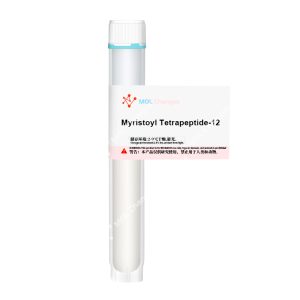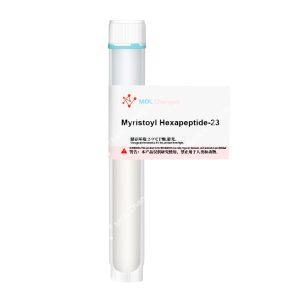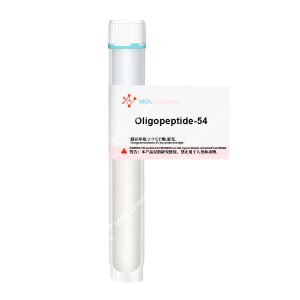Palmitoyl Hexapeptide-14, or more commonly referred to as Palmitoyl Hexapeptide-6, is a synthetic bioactive peptide modified with palmitic acid. Widely used within anti-aging cosmetics, this peptide possesses documented efficacy. The palmitoyl moiety itself plays a significant role in enhancing skin permeability; improved bioavailability being one of the direct results. Targeting key pathways associated with the skin aging process, it mimics certain signaling molecules of the extracellular matrix (ECM).
Sequence
{Pal-Phe}-Ala-Leu-Leu-lys-Leu-NH2
CAS Number
891498-01-4
Molecular Formula
C52H92N8O7
Molecular Weight
941.34 g/mol
Research Of Palmitoyl Hexapeptide-14
The anti-wrinkle efficacy specifically comes from the multifaceted regulatory capacity Palmitoyl Hexapeptide-14 exerts over the skin’s ECM. Skin aging, and subsequent wrinkle formation, is fundamentally a pathophysiological degradation of the structural and functional aspects of said ECM. Reduced levels and increased degradation of structural proteins (collagen being the prime example) are central to this process.
Active intervention and to a large extent ‘reversing’ this degradation is what the peptide is capable of achieving through endogenous mimicry. A synergistic triple mechanism describes how this occurs:
1.Stimulating Fibroblast Proliferation:
Fibroblasts act as the ‘factory cells’ of the dermis, synthesizing all core ECM components. Studies have shown effective stimulation (both in number and general activity) of dermal fibroblasts by this peptide.
Increasing the synthetic capacity of ECM is a primary benefit of using it.
2.Promoting (direct) collagen synthesis:
As mentioned above, collagen is the primary structural protein for tension and elasticity of the skin. Direct signaling from the peptide to fibroblasts leads to near complete replenishment of at least some forms of collagen (Type I/III being the most well documented).
Filling in small to medium wrinkles is a very tangible result of this effect.
3.Inhibiting Matrix Metalloproteinase activity:
Matrix Metalloproteinase/MMP‘s are enzymes that break down the ECM, often abnormally in aged or damaged skin. Palmitoyl Hexapeptide-14’s final and important line of action, protects the ECM (and all newly formed or previously existing collagen) from being broken down.
Net ECM and collagen levels are and remain, to a large degree, improved.
In a 12-week, double-blind, randomized, controlled clinical trial involving 29 female volunteers, a formulation containing Palmitoyl Hexapeptide-14 was compared to the U.S. FDA-approved prescription anti-aging medication Renova® (0.05% tretinoin).
Results showed that after this period of use, Palmitoyl Hexapeptide-14 was comparable to tretinoin in reducing various forms of facial fine lines and wrinkles.
The more common side effects associated with tretinoin – irritation, dryness, and subsequent peeling – were completely absent in the Palmitoyl Hexapeptide-14 group; excellent skin tolerance was the primary takeaway from the study.⁵
The actual mechanism by which Palmitoyl Hexapeptide-14 works involves rebuilding and protecting the skin’s extracellular matrix. A triple synergistic action is responsible: fibroblast proliferation being stimulated, collagen synthesis promoted, and matrix metalloproteinase activity inhibited.
Reducing wrinkles, firmness and elasticity are the desired end points of this process. Anti-wrinkle and skin rejuvenation cosmetics are the main applications; creams and serums being near perfect vehicles for its delivery.
High safety allows for routine combination with other active ingredients.
COA
HPLC
MS









Reviews
There are no reviews yet.